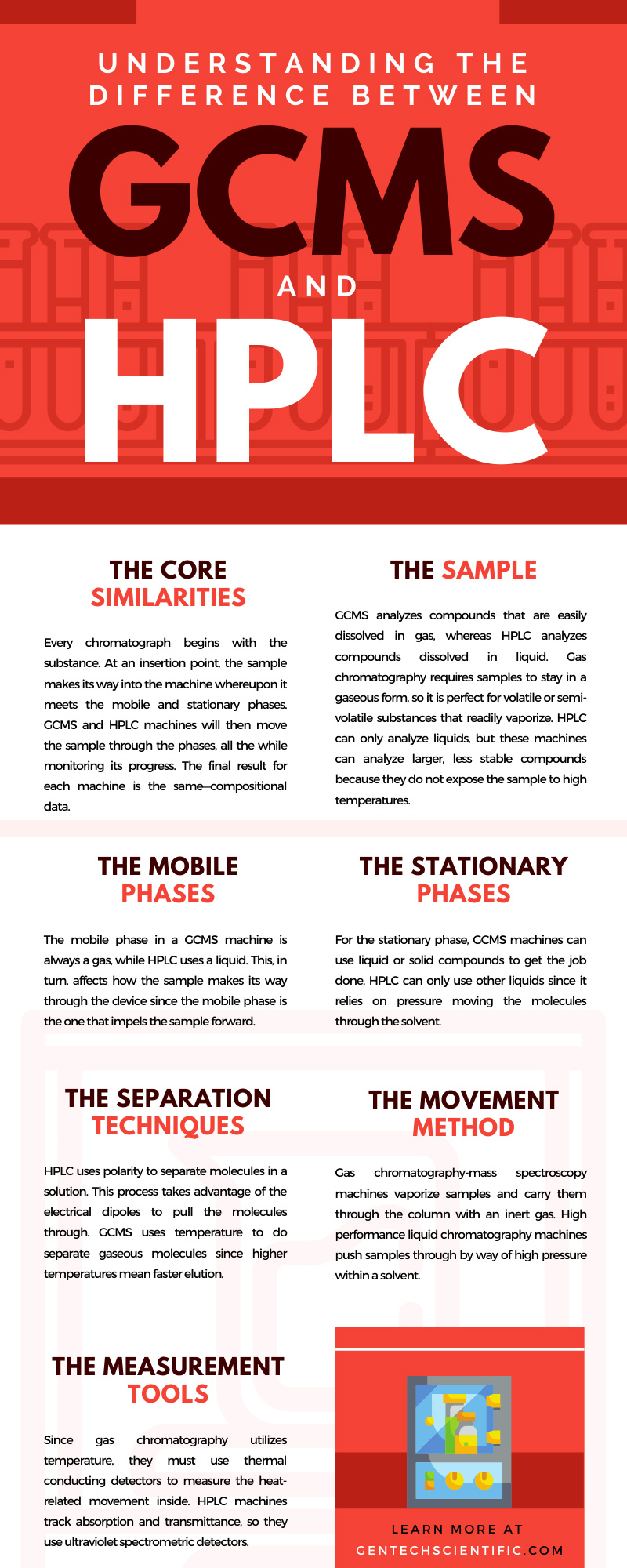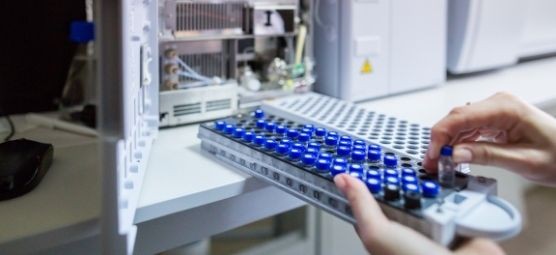Chromatography is one of the main ways that scientists can separate samples and analyze their structure. However, samples come in all forms that require different techniques for measurement. Whether a substance is gaseous or liquid, technicians need to determine its nature. Understanding the difference between GCMS and HPLC is a challenge that requires time and research. Here is a quick guide to these two chromatographical methods and how they compare to each other.
Chromatography Basics
Before diving into the nitty-gritty with GCMS and HPLC, one must understand the basics of chromatography and how scientists use each method. Chromatography is the process by which chemists separate compounds from a mixture. The process operates with the basic assumption that heavy molecules move slower than lighter ones. This varied pace leads to a measurable segmentation in the data that allows technicians to identify compounds.
When you mix red and yellow food dye, you get orange. Suppose you want to unmix the orange liquid back into red and yellow. You would need some chemical method to reverse the process. That’s where chromatography comes in. Though separating food dye is a middle-school-level experiment, technicians working in chromatography must separate complex molecules for real-world applications such as discerning dangerous pesticides in produce.
The Types of Chromatography
The science of chromatography is not monolithic; there are several types that chemists use. The main four types are liquid, gas, thin-layer, and paper chromatography. Each of these types subdivides into further categories, but these are the main four. GCMS and HPLC are two such subcategories within gas and liquid chromatography, respectively.
GCMS stands for gas chromatography-mass spectroscopy, and HPLC refers to high performance liquid chromatography. Each word in their name describes essential aspects of their chromatographical process. In both cases, an analyte enters the machine for assessment that yields molecular data.
The Main Components of Chromatography Machines
Chromatography machines require similar parts to carry out their work. Every chromatograph has a column which the sample travels through. Inside this column are two substances: a mobile phase and a stationary phase. The mobile phase is the part that moves and typically contains the sample. The stationary phase is the part that does not move and includes the absorption material. Depending on the type of chromatography, these phases could be solid, liquid, or gas.
With all internal mechanisms in place, the machine utilizes heat or pressure to move the sample through the phases. For example, a GCMS machinewill use heat to vaporize the sample and initiate the movement inside. Then, fine-tuned tools will measure the sample’s movement over time, resulting in the computer-charted data that technicians can read.
Comparing GCMS and HPLC
GCMS and HPLC are very different chromatographical methods that perform very different work. It is crucial for scientists to compare and understand the two.
The Core Similarities
Though there are myriad differences between GCMS and HPLC, there is one core similarity: the chromatography basics at play.
Chromatographical Method
Chromatography machines use specialized parts for the kind of sample they process, but the core dynamics are often the same. The methodology at play requires the same aspects for proper analysis. Every chromatograph begins with the substance. At an insertion point, the sample makes its way into the machine whereupon it meets the mobile and stationary phases. GCMS and HPLC machines will then move the sample through the phases, all the while monitoring its progress. The final result for each machine is the same—compositional data.
The Key Differences
When it comes down to it, GCMS and HPLC operate in entirely different ways, albeit for the same information. These are the key differences between the two methods.
The Mobile Phases
The mobile phase in a GCMS machine is always a gas, while HPLC uses a liquid. This, in turn, affects how the sample makes its way through the device since the mobile phase is the one that impels the sample forward.
The Stationary Phases
For the stationary phase, GCMS machines can use liquid or solid compounds to get the job done. HPLC can only use other liquids since it relies on pressure moving the molecules through the solvent.
The Sample
GCMS analyzes compounds that are easily dissolved in gas, whereas HPLC analyzes compounds dissolved in liquid. Gas chromatography requires samples to stay in a gaseous form, so it is perfect for volatile or semi-volatile substances that readily vaporize. HPLC can only analyze liquids, but these machines can analyze larger, less stable compounds because they do not expose the sample to high temperatures.
The Column Sizes
The physical machinery also differs between GCMS and HPLC. Gas chromatography needs a larger column for the vaporized substances to move. In fact, GCMS columns can run upwards of several meters. On the other hand, HPLC columns are much smaller and typically span only a few centimeters.
The Separation Techniques
HPLC uses polarity to separate molecules in a solution. This process takes advantage of the electrical dipoles to pull the molecules through. GCMS uses temperature to do separate gaseous molecules since higher temperatures mean faster elution. Gas chromatography machines incrementally heat up the column until they reach several hundred degrees Celsius, ultimately forcing the sample through the system.
The Movement Method
Gas chromatography-mass spectroscopy machines vaporize samples and carry them through the column with an inert gas. High performance liquid chromatography machines push samples through by way of high pressure within a solvent.
The Measurement Tools
Since gas chromatography utilizes temperature, they must use thermal conducting detectors to measure the heat-related movement inside. HPLC machines track absorption and transmittance, so they use ultraviolet spectrometric detectors. These UV sensors understand how a molecule responds to certain light levels and track it on a graph.
Understanding the difference between GCMS and HPLC is essential because each one measures different substances. When a scientist must analyze a sample, they should know whether to use GCMS or HPLC. If you need GCMS or HPLC equipment or have any questions about chromatography, reach out to our team at GenTech Scientific today.







